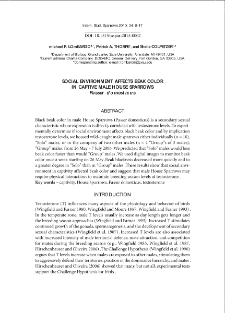Repozytorium Uniwersytetu Zielonogórskiego udostępnia 9 312 obiektów cyfrowych
Obiekt
Tytuł: Social environment affects beak color in captive male House Sparrows "Passer domesticus"
Tytuł publikacji grupowej:
Abstract:
Black beak color in male House Sparrows ("Passer domesticus") is a secondary sexual characteristic whose expression is directly correlated with testosterone levels. To experimentally determine if social environment affects black beak color and by implication testosterone levels, we housed wild-caught male sparrows either individually (n = 10), "Solo" males, or in the company of two other males (n = 4 "Group"s of 3 males), "Group" males, from 26 May - 7 July 2006. ; We predicted that "Solo" males would lose beak color faster than would "Group" males. We used digital images to monitor beak color once a week starting on 26 May. Beak blackness decreased more quickly and to a greater degree in "Solo" than in "Group" males. These results show that social environment in captivity affected beak color and suggest that male House Sparrows may require physical interactions to maintain breeding season levels of testosterone.
Wydawca:
Zielona Góra: University of Zielona Góra, Faculty of Biological Sciences
Format:
Identyfikator zasobu:
DOI:
Strony:
Źródło:
International Studies on Sparrows, vol. 34
Jezyk:
Prawa do dysponowania publikacją:
Biblioteka Uniwersytetu Zielonogórskiego
Kolekcje, do których przypisany jest obiekt:
- Repozytorium > Jednostki organizacyjne > Wydział Nauk Biologicznych
- Repozytorium > Typy utworów > Artykuły
- Repozytorium > Czasopisma naukowe i serie wydawnicze UZ > International Studies on Sparrows
Data ostatniej modyfikacji:
23 maj 2023
Data dodania obiektu:
4 maj 2023
Liczba wyświetleń treści obiektu:
181
Wszystkie dostępne wersje tego obiektu:
https://zbc.uz.zgora.pl/repozytorium/publication/81555
Wyświetl opis w formacie RDF:
Wyświetl opis w formacie OAI-PMH:
| Nazwa wydania | Data |
|---|---|
| Social environment affects beak color in captive male House Sparrows "Passer domesticus" | 23 maj 2023 |
Obiekty Podobne
Lombardo, Michael P. Thorpe, Patrick A.
Stewart, Ian R.K. Westneat, David F.
Stewart, Ian R.K. Wetzel, Daniel P. Westneat, David F.
Bijith, Puthiyaveettil Roshnath, Ramesh
Grouw, Hein van
Jayaraman, Ariyappan Ramakrishnan, Balasundaram Samson, Arockianathan

